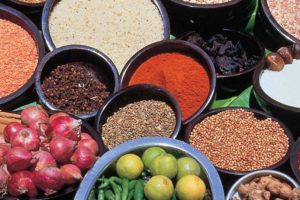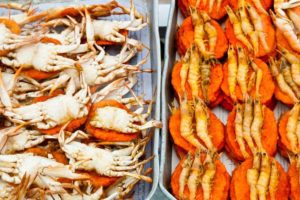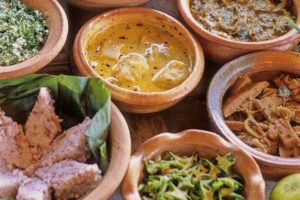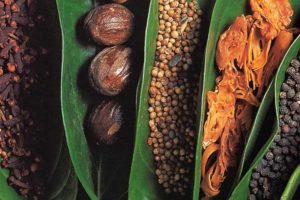SRI LANKA – Culinary experience
 When you hear the words “Sri Lanka”, you think of golden beaches, sunsets, tea or cricket teams. However, those who visit Sri Lanka come for the tropical sunsets but stay for the food. The food in Sri Lanka is like no other. Filled with aromatic spices and vibrant colors, Sri Lankan food will leave you happy, warm, and contented. For every native Sri Lankan there is nothing better than a hearty plate of rice and curry. So much so that most Sri Lankans insist on carrying glasses of homemade curry or spices when traveling abroad.
When you hear the words “Sri Lanka”, you think of golden beaches, sunsets, tea or cricket teams. However, those who visit Sri Lanka come for the tropical sunsets but stay for the food. The food in Sri Lanka is like no other. Filled with aromatic spices and vibrant colors, Sri Lankan food will leave you happy, warm, and contented. For every native Sri Lankan there is nothing better than a hearty plate of rice and curry. So much so that most Sri Lankans insist on carrying glasses of homemade curry or spices when traveling abroad.
 While spiciness is an essential characteristic of Sri Lankan food, curry is definitely another one. There are many different curries in Sri Lanka with a variety of different vegetables, meats and spices. When you think of rice and curry, immediately think of a full plate of rice, spicy meat curry, dal curry, papadum (crispy fried crackers), mallum (green salad), and deep-fried red chillies as an added kick. The Sri Lankan curry ranges from the not-too-spicy kiri hodi and slightly spicy Dal curry to the spicy chicken curry that is everyone’s favorite. From Lunu Miris (spicy onion sambol) and Pol Sambol (coconut sambol) to Maalu Ambulthiyal (fish curry), the variety and variation of Sri Lankan curries and sambols is endless and a must for anyone visiting Sri Lanka. But wait! You don’t just eat curry with rice! Sri Lankan cuisine offers a variety of unique Sri Lankan foods such as Indi Appa (string funnels), Appa (funnels), Pittu and Roti, which can be perfectly combined with the various curries and sambols.
While spiciness is an essential characteristic of Sri Lankan food, curry is definitely another one. There are many different curries in Sri Lanka with a variety of different vegetables, meats and spices. When you think of rice and curry, immediately think of a full plate of rice, spicy meat curry, dal curry, papadum (crispy fried crackers), mallum (green salad), and deep-fried red chillies as an added kick. The Sri Lankan curry ranges from the not-too-spicy kiri hodi and slightly spicy Dal curry to the spicy chicken curry that is everyone’s favorite. From Lunu Miris (spicy onion sambol) and Pol Sambol (coconut sambol) to Maalu Ambulthiyal (fish curry), the variety and variation of Sri Lankan curries and sambols is endless and a must for anyone visiting Sri Lanka. But wait! You don’t just eat curry with rice! Sri Lankan cuisine offers a variety of unique Sri Lankan foods such as Indi Appa (string funnels), Appa (funnels), Pittu and Roti, which can be perfectly combined with the various curries and sambols.
 One of the reasons Sri Lanka is an ideal destination for travelers and food lovers is the multicultural nature of the country. Sri Lankan cuisine is the culmination of various foods from the different cultures of the country. Each ethnic community in Sri Lanka has its own unique contribution to Sri Lankan cuisine. The Sinhalese community is known for foods like kiribath (rice pudding) and the variety of festive sweets like kavum, kokis, aluwa etc. The Tamil community offers a range of delicious foods like dosai, idly, wadei, murukku etc and delicious sweets like kesari, jalebi and Laddoo etc. Faluda, Biryani and Wattalapam are foods that have their roots in the Muslim community of Sri Lanka. Burgher parish is known for their lamprais, rich cakes, and Sri Lankan style crepes / pancakes filled with pani pol (desiccated coconut with honey) which are just what you need to get the most out of your evening cup of tea.
One of the reasons Sri Lanka is an ideal destination for travelers and food lovers is the multicultural nature of the country. Sri Lankan cuisine is the culmination of various foods from the different cultures of the country. Each ethnic community in Sri Lanka has its own unique contribution to Sri Lankan cuisine. The Sinhalese community is known for foods like kiribath (rice pudding) and the variety of festive sweets like kavum, kokis, aluwa etc. The Tamil community offers a range of delicious foods like dosai, idly, wadei, murukku etc and delicious sweets like kesari, jalebi and Laddoo etc. Faluda, Biryani and Wattalapam are foods that have their roots in the Muslim community of Sri Lanka. Burgher parish is known for their lamprais, rich cakes, and Sri Lankan style crepes / pancakes filled with pani pol (desiccated coconut with honey) which are just what you need to get the most out of your evening cup of tea.
 Street food is a must when it comes to Sri Lankan cuisine. Kottu is without a doubt one of the most defining street food products in Sri Lanka. Kottu consists of shredded Gothamba roti, vegetables, meat and a healthy serving of spicy curry. It is the ultimate Sri Lankan comfort food and is easily one of the top ten foods to try in Sri Lanka before you die. In fact, most Sri Lankan teenagers like a plate of creamy cheese kottu after a long night of drinking. You just can’t walk down a street in Sri Lanka without seeing a cart or display case full of colorful, fruity drinks, isso wadei, samosas, achcharu, cassava chips, etc. that you just want to buy. Another important and unique element of Sri Lankan cuisine is the “short eat”. Consisting of patties, schnitzel, Chinese rolls, maalu paan (fish rolls) and various types of pastries, short meals are always there when you have a morning snack with your evening tea or need a quick breakfast.
Street food is a must when it comes to Sri Lankan cuisine. Kottu is without a doubt one of the most defining street food products in Sri Lanka. Kottu consists of shredded Gothamba roti, vegetables, meat and a healthy serving of spicy curry. It is the ultimate Sri Lankan comfort food and is easily one of the top ten foods to try in Sri Lanka before you die. In fact, most Sri Lankan teenagers like a plate of creamy cheese kottu after a long night of drinking. You just can’t walk down a street in Sri Lanka without seeing a cart or display case full of colorful, fruity drinks, isso wadei, samosas, achcharu, cassava chips, etc. that you just want to buy. Another important and unique element of Sri Lankan cuisine is the “short eat”. Consisting of patties, schnitzel, Chinese rolls, maalu paan (fish rolls) and various types of pastries, short meals are always there when you have a morning snack with your evening tea or need a quick breakfast.
 Given the myriad of flavors and textures found in Sri Lankan cuisine, there is no doubt that Sri Lankan cuisine is a phenomenal gastronomic adventure. From fine dining to roadside restaurants and street vendors, Sri Lanka offers a unique and flavourful dining experience for all travelers. When you visit Sri Lanka, you will experience the cuisine of not just one but four different cultures that blend seamlessly into a type of cuisine that can only be defined as inherently Sri Lankan.
Given the myriad of flavors and textures found in Sri Lankan cuisine, there is no doubt that Sri Lankan cuisine is a phenomenal gastronomic adventure. From fine dining to roadside restaurants and street vendors, Sri Lanka offers a unique and flavourful dining experience for all travelers. When you visit Sri Lanka, you will experience the cuisine of not just one but four different cultures that blend seamlessly into a type of cuisine that can only be defined as inherently Sri Lankan.

